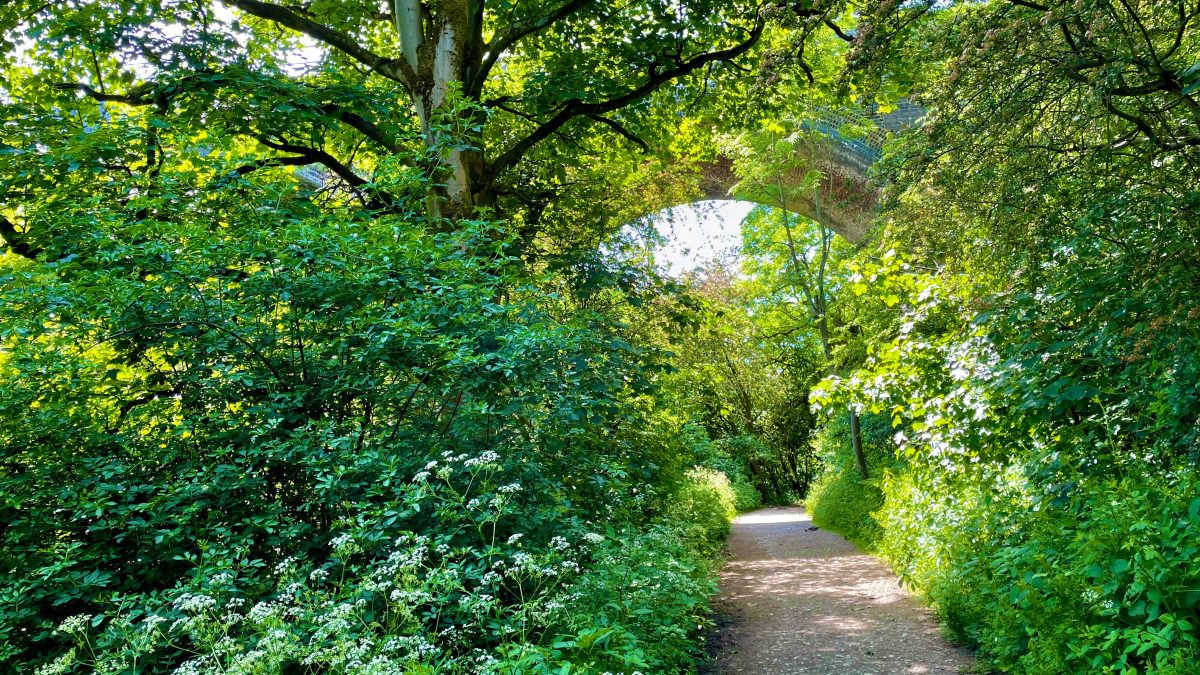Cross the historic boundaries of Cheshire and Lancashire on a surprising loop through Greater Manchester’s green belt that’s mostly off-road (if often imperfectly so), taking in the Goyt and Tame valleys, Reddish Vale, Marple Locks and an eerie old Stockport railway tunnel.
Route details
- Distance
 15.6 miles / 25.1 km
15.6 miles / 25.1 km - Elevation Gain
 225 m / 739 ft
225 m / 739 ft - Time allow 1 hour 45 minutes
- Difficulty
 Gentle
Gentle - Suited to
 All Bikes
All Bikes  Gravel Bikes
Gravel Bikes  Mountain Bikes
Mountain Bikes
- Suggested Start SK5 7HG SJ 9043 9346
- Places Bredbury, Brinnington, Denton, Greater Manchester, Haughton Green, Marple, Reddish, Reddish Vale Country Park, Romiley, Rose Hill, Stockport, Tameside, Woodley
- Attributes Accessible by train, Bridges, Canals, Car parking, Circular loop, Family-friendly, Gentle climbs, Mud and puddles, National Cycle Network, Railways, Rivers, Short sharp climbs, Suitable for older kids, Tunnels, Urban, Views of open countryside, Woodlands and forests
How to unlock
Support the website for £10 to access everything…
Become a Peaks & Puddles Plus supporter for a one-off contribution and you’ll get access to all these exclusive extra pages — plus downloadable, phone-friendly Pocket Guides and over 70 GPX navigation files to take along for the ride.

Peaks & Puddles Plus
• All Plus route pages
• GPX Collection: over 70 navigation files
• Pocket Guides: 10 downloadable, printable guides to the most popular routes
For a one-off contribution, supporting my work and website running costs.
What you’ll receive
You’ll be provided immediately with the link to a hidden page where all these extra downloads and guides (marked Plus) can be accessed. Return any time to access new and updated content just thanks to that single contribution. As an extra bonus, I’ve made sure Plus guide pages are completely ad-free.
Thanks for your support!
I’m reserving these original routes and extra pages exclusively for supporters. The one-off contribution supports my work and website costs, with miles of cycling inspiration in return. This online guidebook is still growing, I’m nowhere near done yet, so it’s a great investment in my future plans. Thank you!
Anthony
Original photography, words and design by Anthony Sheridan unless indicated otherwise. Found this guide helpful? Buy me a coffee to help keep the wheels turning!
The all-important disclaimer: While great care and attention has been put into gathering these routes, ensuring details are accurate and determining their suitability, all information should be used as a guide only and is not a replacement for using your own judgement or research when setting out on new adventures. Peaks & Puddles/the author cannot be held responsible for any issues that may arise from the riders own decision to ride a section of indicated route.
Always ensure your equipment is safe and legal for use and that you are well prepared, carrying everything necessary including access to a good map. Follow the Highway Code and the Countryside Code at all times. Respect the landscape, the wildlife and the people you encounter. And after all that, have fun!

